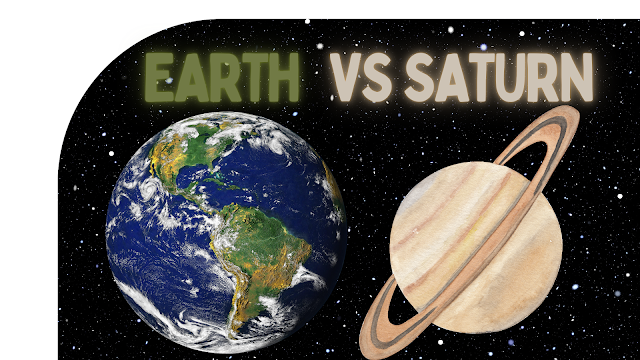The vastness of the universe is filled with countless celestial bodies, each offering unique features and captivating mysteries. In this article, we delve into a comparative analysis of Earth and Saturn, two celestial entities that have captured the imagination of scientists and stargazers alike. From their physical characteristics to their atmospheres, rings, and potential for supporting life, we will explore the intriguing similarities and differences between Earth and Saturn.
 |
| Earth vs Saturn: A Comparative Analysis of Two Celestial Bodies |
I. Physical Characteristics
Earth
- Size and Composition: Earth is the third planet from the Sun and the fifth-largest planet in the solar system. It has a diameter of approximately 12,742 kilometers and is composed of a solid inner core, liquid outer core, mantle, and crust.
- Geology and Surface Features: Earth boasts a diverse range of surface features, including continents, oceans, mountains, valleys, deserts, and more. Its surface is primarily covered by water, making it a unique "blue planet."
- Magnetic Field: Earth possesses a strong magnetic field generated by its molten iron outer core. This magnetic field helps protect the planet's atmosphere from harmful solar radiation.
Saturn
- Size and Composition: Saturn is the sixth planet from the Sun and the second-largest planet in the solar system. With a diameter of approximately 116,464 kilometers, it is nearly ten times larger than Earth. Saturn consists mainly of hydrogen and helium, with a small rocky core.
- Structure: Saturn has a complex internal structure, including a dense core surrounded by metallic hydrogen, a layer of liquid hydrogen, and an upper atmosphere composed primarily of molecular hydrogen.
- Gas Giant: Saturn is classified as a gas giant due to its lack of a solid surface. It features an outer layer of gaseous clouds that give it a distinct yellowish appearance.
II. Atmospheres
Earth
- Composition: Earth's atmosphere is predominantly composed of nitrogen (78%) and oxygen (21%), with trace amounts of other gases such as carbon dioxide, water vapor, and noble gases.
- Life-Supporting Atmosphere: The presence of oxygen and a stable climate make Earth's atmosphere ideal for supporting diverse forms of life. It also protects the planet from harmful solar radiation and regulates temperatures.
Saturn
- Composition: Saturn's atmosphere consists primarily of molecular hydrogen (96%) and helium (3%), with trace amounts of other elements. It also contains traces of ammonia, methane, and water vapor.
- Unique Weather Patterns: Saturn experiences intense weather phenomena, including powerful storms, high-speed winds, and distinctive cloud bands. The planet's atmosphere exhibits a hexagonal cloud pattern at its north pole.
III. Rings
Earth
No Rings: Earth does not possess any prominent ring systems. However, it has a multitude of satellites, including the Moon, which orbits around it.
Saturn
Spectacular Rings: Saturn is renowned for its magnificent ring system, consisting of thousands of individual rings made up of ice particles and dust. These rings span an impressive distance from the planet's surface and are visible from Earth with a telescope.
IV. Potential for Supporting Life
Earth
Abundant Life Forms: Earth is teeming with an extraordinary variety of life forms, including plants, animals, and microorganisms. The presence of liquid water, a stable atmosphere, and suitable temperatures make it a habitable planet.
Saturn
Unlikely for Complex Life: Saturn's extremely cold temperatures, lack of a solid surface, and predominantly gaseous composition make it highly unlikely to support complex life forms as we know them. However, some of Saturn's moons, such as Enceladus and Titan, show potential for hosting microbial life in subsurface oceans and methane lakes, respectively.
Conclusion
In this exploration of Earth and Saturn, we have witnessed the contrasting features and characteristics of these two captivating celestial bodies. Earth's uniqueness lies in its ability to sustain a rich tapestry of life forms, while Saturn captivates us with its mesmerizing rings and intriguing moons. Each offers its own allure and scientific mysteries waiting to be unraveled. As we continue to explore and learn about the universe, the comparison between Earth and Saturn serves as a reminder of the vast wonders that await our discovery beyond the confines of our own planet.


0 Comments